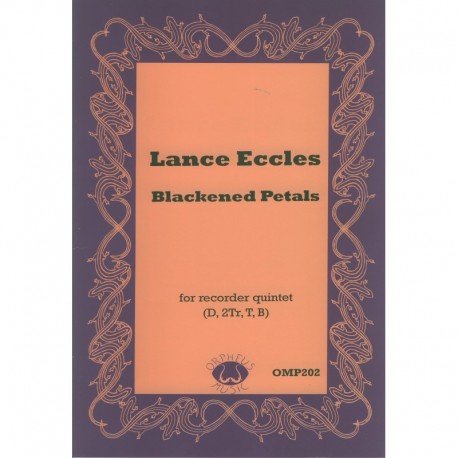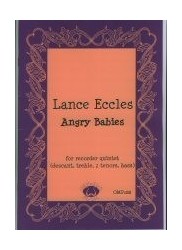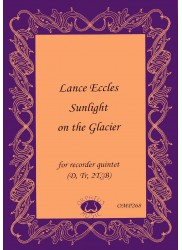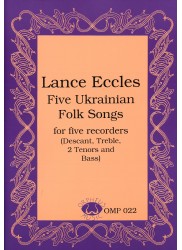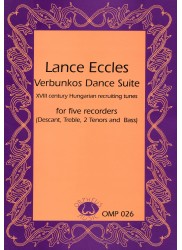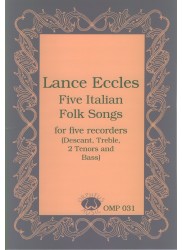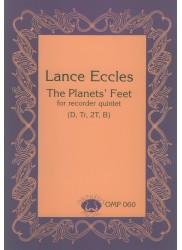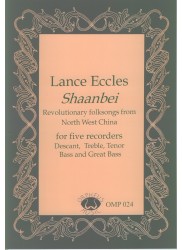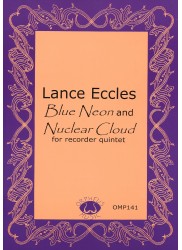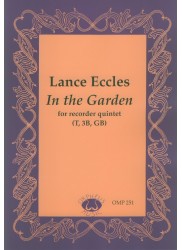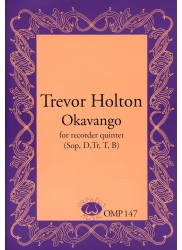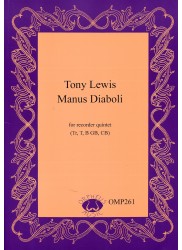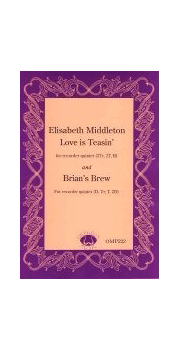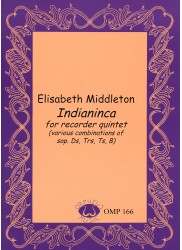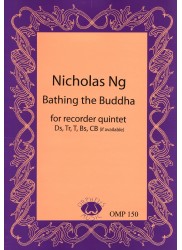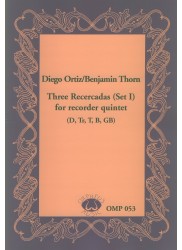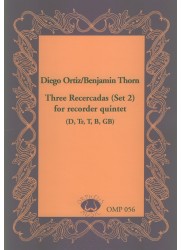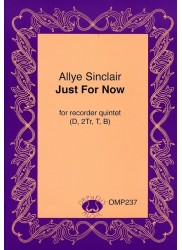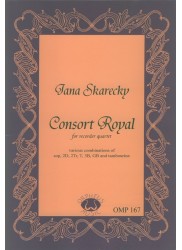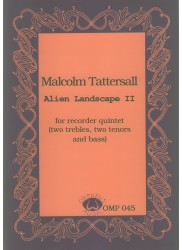No products
Prices are tax included
Blackened Petals
OMP202.pdf
PLEASE NOTE - DOWNLOADABLE PDF VERSION
Composer: Eccles - Lance
Instrumentation: Descant - 2 Trebles - Tenor - Bass
Period/genre: Australian Contemporary
Grade: Moderate
More info
*Contemporary Composition.* A slightly perverse versions of Sakure and Tannenbaum. Fun to play. M
1. Black Cherry Blossoms (Sakure)
2. Charred Christmas Tree (Tannenbaum)
Please note that due to the automated delivery of virtual products including pdf downloads, PayPal payment is required at the checkout - we are unable to accept the cheque payment method for these items.
_Score 5 pp. Parts 2 pp. Downloadable PDF file._
OMP199 Lance Eccles Four Portuguese Folksongs
OMP202 Lance Eccles Blackened Petals
Lance Eccles is one of Australia's leading composers/arrangers. He arranges in a very individual and accessible manner. The edition provides as background that he was a member of the Reluctant Consort for 20 years. Many of his recorder compositions and arrangements have been written either for that group, for the Sydney Society of Recorder Players or for Batalla Famossa. He recently retired as a senior lecturer in Chinese at Macquarie University.
Our group found all of these review pieces to be enjoyable, with some likely to become regularly-used favorites.
Four Portuguese Folksongs includes four short pieces that are appropriate for an intermediate-level group, each with its own challenge and twist on the tunes. Since we were not familiar with the folk songs, markings to show phrasing would have helped to show the shape of the tunes in all four pieces.
"Oh Ciranda" is easy to play, with the soprano carrying the melody throughout and other parts serving as accompaniment. It has a calliope-type effect.
"Oh Ciranda" is easy to play, with the soprano carrying the melody throughout and other parts serving as accompaniment. It has a calliope-type effect.
"My Love Gave Me a Handkerchief " is light and dance-like, with the tune alternating between the soprano and alto lines. The danger is to play it note by note, and it took us a few times to find the shape of the phrases for the most effective performance. It ends abruptly, which can be effective if done intentionally.
"Cornfields" has very challenging rhythms, alternating between a duple 6/8 and a triple 3/4. Since the parts often play 6/8 in one against 3/4 in the others, or other combinations, each player must keep a solid sense of the tempo. We found it best to practice parts with similar rhythms together, before adding the cross-rhythm. Also, it starts low in the range in the bottom three parts, making it difficult for them to establish the rhythmic base for the piece before the entrance of the soprano line. This piece takes work up front, but is very satisfying when it all comes together.
"The Dove Fell into the Sea" is a jazzy and bright piece, each part moving independently. It starts with the lower three parts setting the mood by playing in unison for eight measures, until the soprano comes in with the tune. Then the top three lines engage in echoing or contrasting with each other while the bass provides a ground.
Blackened Petals includes two contemporary pieces that use dissonance to create different kinds of moods for each piece. The publisher aptly describes this set as "slightly perverse" versions of familiar songs.
"Black Cherry Blossoms (Sakura)" sets a traditional Japanese folk song within dissonant chords into a unique and beautiful setting. The soprano and two alto recorders are often high in their range, and the parts need to be played sensitively and in tune in that range for the piece to be effective. The bass provides the rhythmic anchor for the other parts. The ensemble is challenged to find the correct blend of the parts for the dissonance to be effective, but the result is well worth the effort.
"Charred Christmas Tree (Tennenbaum)" is a humorous twist on the often sentimentalized song. It begins with the tune partially hidden by various distortions and modulations, and moves slowly into a more recognizable form. The piece finally ends with the familiar melody and harmonies. This would be a delightful bit of humor for a Christmas program.
Both of these pieces could be used with multiple players on a part, with the exception of the soprano line, which would be best left as a solo by an excellent player.
Bruce Calvin, American Recorder, September 2010.
30 other products in the same category:
Reference: OMP188
Brand: Orpheus Music
Angry Babies
Composer: Eccles - Lance Instrumentation: Descant - Treble - 2 Tenors - Bass...
In StockReference: OMP188.pdf
Brand: Orpheus Music
Angry Babies
PLEASE NOTE - DOWNLOADABLE PDF VERSION Composer: Eccles - Lance...
$25.00 -20%In StockReference: OMP268
Brand: Orpheus Music
Sunlight on the Glacier
Composer: Eccles - Lance Instrumentation: Descant - Treble - 2 Tenors - Bass...
In StockReference: OMP268.pdf
Brand: Orpheus Music
Sunlight on the Glacier
PLEASE NOTE - DOWNLOADABLE PDF VERSION Composer: Eccles - Lance...
$22.00 -20%In StockReference: OMP022.pdf
Brand: Orpheus Music
Five Ukranian Folk Songs
PLEASE NOTE - DOWNLOADABLE PDF VERSION Composer: Eccles - Lance...
$23.50 -20%In StockReference: OMP026.pdf
Brand: Orpheus Music
Verbunkos Dance Suite
PLEASE NOTE - DOWNLOADABLE PDF VERSION Composer: Eccles - Lance...
$23.50 -20%In StockReference: OMP031.pdf
Brand: Orpheus Music
Five Italian Folk Songs
*PLEASE NOTE > DOWNLOADABLE-ONLY PDF VERSION Composer: Eccles - Lance...
$23.50 -20%In StockReference: OMP060
Brand: Orpheus Music
The Planet's Feet
Composer: Eccles - Lance Instrumentation: Descant - Treble - 2 Tenors - Bass...
In StockReference: OMP024
Brand: Orpheus Music
Shaanbei Four Folk Songs North-West China
Composer: Eccles - Lance Instrumentation: Descant - Treble - Tenor - Bass -...
In StockReference: OMP024.pdf
Brand: Orpheus Music
Shaanbei Four Folk Songs North-West China
PLEASE NOTE - DOWNLOADABLE PDF VERSION Composer: Eccles - Lance...
$23.50 -20%In StockReference: OMP141.pdf
Brand: Orpheus Music
Blue Neon and Nuclear Cloud
PLEASE NOTE - DOWNLOADABLE PDF VERSION ONLY Composer: Eccles - Lance...
$19.00 -20%In StockReference: OMP141
Brand: Orpheus Music
Blue Neon and Nuclear Cloud
Composer: Eccles - Lance Instrumentation: Descant - 2 Trebles - Tenor - Bass...
In StockReference: OMP251
Brand: Orpheus Music
In the Garden
Composer: Eccles - Lance Instrumentation: Tenor - 3 Basses - Greatbass...
In StockReference: OMP251.pdf
Brand: Orpheus Music
In the Garden
PLEASE NOTE - DOWNLOADABLE PDF VERSION Composer: Eccles - Lance...
$19.00 -20%In StockReference: OMP147.pdf
Brand: Orpheus Music
Okavango
PLEASE NOTE - DOWNLOADABLE PDF VERSION ONLY. Composer: Holton - Trevor...
$22.00 -20%In StockReference: OMP147
Brand: Orpheus Music
Okavango
Composer: Holton - Trevor Instrumentation: Sopranino - Descant - Treble -...
In StockReference: OMP261
Brand: Orpheus Music
Manus Diaboli
Composer: Lewis - Tony Instrumentation: Treble - Tenor - Bass - Greatbass -...
In StockReference: OMP222
Brand: Orpheus Music
Love is Teasin' & Brian's Brew
Composer: Middleton - Elisabeth Instrumentation: Descant - Treble - Tenor -...
In StockReference: OMP222.pdf
Brand: Orpheus Music
Love is Teasin' & Brian's Brew
PLEASE NOTE - DOWNLOADABLE PDF VERSION Composer: Middleton - Elisabeth...
$19.00 -20%In StockReference: OMP166*
Brand: Orpheus Music
Indianinca
Composer: Middleton - Elisabeth Instrumentation: Sopranino - Descant -...
In StockReference: OMP166.pdf
Brand: Orpheus Music
Indianinca
PLEASE NOTE - DOWNLOADABLE PDF VERSION Composer: Middleton - Elisabeth...
$19.00 -20%In StockReference: OMP150
Brand: Orpheus Music
Bathing the Buddha
Composer: Ng - Nicholas Instrumentation: Tenor - Bass + optional Contrabass...
In StockReference: OMP053
Brand: Orpheus Music
Three Recercadas Set 1
Composer: Ortiz - Diego Arranger: Benjamin Thorn Instrumentation: Descant -...
In StockReference: OMP053.pdf
Brand: Orpheus Music
Three Recercadas Set 1
PLEASE NOTE - DOWNLOADABLE PDF VERSION Composer: Ortiz - Diego Arranger:...
$25.00 -20%In StockReference: OMP056*
Brand: Orpheus Music
Three Recercadas Set 2
Composer: Ortiz - Diego Arranger: Benjamin Thorn Instrumentation: Descant -...
In StockReference: OMP056.pdf
Brand: Orpheus Music
Three Recercadas Set 2
*PLEASE NOTE > DOWNLOADABLE-ONLY PDF VERSION Composer: Ortiz - Diego...
$22.00 -20%In StockReference: OMP237
Brand: Orpheus Music
Just For Now
Composer: Sinclair - Allye Instrumentation: Descant - 2 Trebles - Tenor -...
In StockReference: OMP237.pdf
Brand: Orpheus Music
Just For Now
PLEASE NOTE - DOWNLOADABLE PDF VERSION Composer: Sinclair - Allye...
$22.00 -20%In StockReference: OMP167.pdf
Brand: Orpheus Music
Consort Royal
PLEASE NOTE - DOWNLOADABLE PDF VERSION Composer: Skarecky -...
$31.00 -20%In StockReference: OMP045
Brand: Orpheus Music
Alien Landscape II
Composer: Tattersall - Malcolm Instrumentation: 2 Trebles - 2 Tenors - Bass...
In Stock

